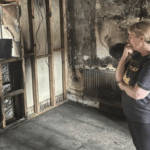A balloon carrying rubbish from North Korea landed on a rooftop in Seoul, igniting a fire, according to the city’s Gangseo Fire Station. The incident occurred at approximately 9:04 p.m. local time (1:04 a.m. Irish time) on Sunday, at a four-story commercial building in the western district of Seoul.
The fire was quickly contained within 18 minutes, with 15 fire trucks and 56 personnel responding to the emergency. Fortunately, there were no reported casualties. Military and police authorities have since collected the balloon, which is under investigation.
This incident is part of a larger pattern of balloon-related provocations between North and South Korea. According to South Korea’s military, Pyongyang launched approximately 120 balloons filled with waste towards the South on Saturday night, following another 50 balloons sent earlier that day. The Joint Chiefs of Staff (JCS) reported that around 40 of these balloons had already landed in South Korea, primarily in northern Gyeonggi Province and the capital, Seoul. The balloons contained mostly paper and plastic waste, posing no immediate safety risk to the public.
Since May, North Korea has dispatched over 5,000 such balloons as a response to South Korean activists’ propaganda balloons. In retaliation, Seoul has suspended a military tension-reducing agreement with Pyongyang and resumed propaganda broadcasts from loudspeakers along the border.
Earlier this month, similar balloons equipped with timer devices caused fires near an airport and a storage unit. JCS spokesperson Lee Chang-hyun explained that these balloons use thermal timers to separate from their load mid-air. “The method involves a thermal timer that heats the balloon’s material, causing it to tear apart in mid-air,” Lee said, clarifying that these are not ‘timer explosions’ but controlled detachment.
Lee also noted that shooting down the balloons could lead to hazardous debris, making the collection of fallen balloons the safest approach for now. Yang Uk, a research fellow at the Asan Institute for Policy Studies, suggested that North Korea might be using data to predict where the balloons will land and then detonate the devices mid-air to target specific areas.
While no injuries or significant damage have been reported, Yang warned that such incidents could escalate, particularly during dry seasons when the risk of fires is higher.

















